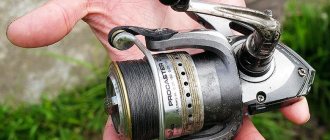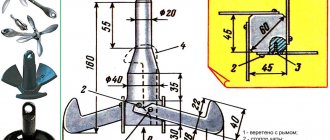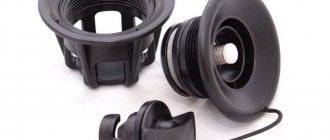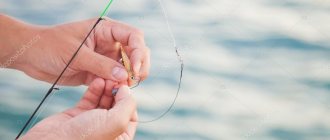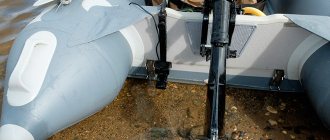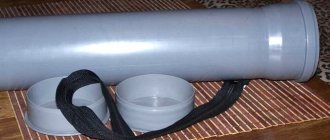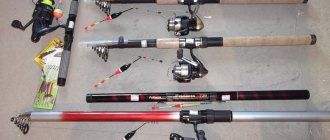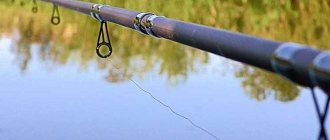How to make a fishing rod stand with your own hands?
Any angler will agree that having a rod stand simplifies the process. You can install several rods on this device at once, so you don’t have to hold the equipment in your hands and strain. There is a wide selection of such holders on the market today, but you can make your own if you follow simple instructions. The stand can be made from wood, plastic, metal wire, with only basic tools and simple materials on hand. We offer you several options for making holders and useful recommendations.
Making a holder for an onboard fishing rod with your own hands
The base can be made from a wooden block of suitable size. To do this you need:
- saw off one of its sides so that it lies flat on the side of the boat;
- drill a longitudinal hole in it;
- cut a groove so that it fits onto the rail;
- coat the block with several layers of varnish so that it lasts a long time (the best option is yacht varnish, the protective coating made from it is the most durable).
For fixing fishing rods, a PVC plumbing pipe is best suited. A good option is to place two pieces of it on different sides of the base of the holder. Make cutouts in them for the spinning rod leg if you are going to fish with this type of reel. Thanks to these cutouts, the rods will be clearly fixed in the holder without twisting. It is much more convenient to use this design.
An important advantage of plastic plumbing pipes is that they will not damage the fishing rod. Ready-made holders for onboard fishing rods, which you can buy in a store, often have metal pipes. When the boat constantly rocks on the waves and - especially - when crossing a pond with oars or under a motor, fishing rods in such metal glasses are easily injured.
Plastic pipes are attached to the block using a pipe clamp. They can be placed at different angles.
You can attach a plastic food container to the bar. The result is a convenient storage for baits, in which they will always be at hand.
[custom_ads_shortcode1]
Tools and materials
Before you start making the holder, you need to carefully prepare so that everything is at hand. The set of tools and materials directly depends on what kind of device you decide to build yourself. The design elements can be made of wood, a metal hanger, or even foam plastic, so first you need to decide on the components, and only then proceed to the craft itself.
You may need smooth fittings with a diameter of no more than 0.6 mm, plastic and metal tubes of different sizes; for vertical posts you need larger pieces with a diameter of up to 50 mm and wooden pegs.
The work will not take much time or effort, moreover, this is one of the most affordable options, because to make a stand for a fishing rod you do not need anything expensive, you just need to collect available materials.
Some fishermen are able to build a homemade stand from ordinary thick wire or even a ski pole. Of course, after all the materials have been prepared, it is necessary to develop drawings in order to calculate the parameters of the future holder. To draw a diagram, it is important to decide what dimensions the structure should be.
As for tools, you cannot do without a large knife or axe; it is also important to have a jigsaw and scissors, thick thread and Moment glue. Now you can begin the process yourself. If you want to make a belt attachment for fishing from the shore, you will need to be equipped with a tarpaulin or thick fabric.
How to make a holder with your own hands
To save money, fishermen make their own fishing rod holder.
Materials used
A homemade fishing rod stand does not require much expense or effort. It is easy to make from scrap materials.
A simple stand for 1 spinning rod is made from thick wire, a tube or a ski pole. A holder for 2 or more fishing rods is made of wire, bent in a spiral, which is attached to ski poles.
Lovers of wading fishing make holders that they put on their belts. They are made from sewn pieces of tarpaulin and fabric. A plastic tube for the fishing rod handle is inserted into the layers of fabric.
Holders can be made from a hanger. To do this, you need to cut off the hook of the hanger and wrap the lower part with rope. To move the fishing line, the threads must be wound at a distance of 6 cm. Instead of a signaling device, you can use a bell. Using the same scheme, you need to make a hanger for the rear attachment of the fishing rod. A metal rod is inserted into the upper part of the hanger and secured to the racks.
The stands are also made from plywood.
Drawings and tools
In order to make a fishing rod holder yourself, all you need to do is draw a sketch, but diagrams and drawings are not required. You will also need various tools:
- an ax or large knife (for making wooden pegs);
- awl and thick thread (for the hip holder);
- scissors and jigsaw (for plywood holder).
To make your own fishing rod stands with plywood slats, you need to cut 2 slats from a sheet of plywood. Use a jigsaw to make recesses for fishing rods in the front plank. You have to cut a lot of holes in the back bar to hold the rod at different angles. Then the planks must be connected to stakes or tubes using screws. The finished structure needs to be painted.
Homemade rod-pod
The rod-pod is manufactured according to the following scheme:
- Making legs. Stainless steel tubes or a tripod are suitable for this.
- The prepared legs are welded to a round platform (washer).
- At the third stage, the upper part is made. To do this, one metal plate is welded to the washer, and the second to a separate pipe. After this, the 2 plates are fastened together with a bolt. Buzbars and stands for them can be purchased ready-made. Their cost is small, and buying new ones will reduce the time it takes to manufacture a rod-pod.
- At the last stage, the entire structure needs to be painted.
Manufacturing options
Made of plastic
This option for spinning is in great demand. To do this you will need a PVC pipe and a small piece of reinforcement. When it comes to diameter, you need to make sure that the bottom of your rod will fit inside. The essence of making a stand is to attach the fittings to the pipe using special glue; some people prefer to use tape, but this is not always reliable. It is important to put in the effort and make sure the connection is secure and strong.
The other end of the reinforcement is sharpened with a grinder, which almost every angler has, but if you don’t have a tool, it’s enough to leave the cut at an acute angle. Despite the simplicity of this device, it should be understood that fastening with tape will not be so reliable. However, a holder made from polypropylene pipes is in great demand, so you can try making one yourself in your garage.
It is worth noting that such a stand is suitable for feeder fishing, when the equipment needs to be fixed in a stationary position, and the tip of the rod will serve as a signaling device indicating bites. In addition, thanks to this device you can easily handle your fishing equipment. Feed holders for carp rods have the following advantages.
First of all, any angler can make them, they are easy to use, they are a compact device that will not take up much space during transportation.
Made of wood
From foam plastic
As surprising as it may sound, polystyrene foam can also be suitable as a material for making a shore stand. The construction method is similar to that used with plastic. The holder must be made in the shape of a disk, the thickness of which is at least 0.5 mm.
To cut such a circle, just use a simple knife; a third of the total material is cut off at the bottom to ensure stability, then all that remains is to drill a hole.
From a metal hanger
Since almost every home has a hanger, you can make a good stand out of it without spending any more effort. The inverted device must be bent in a special way. This is an alternative option to wooden pegs. It is worth noting that this type of holder is convenient and can be not only one-piece, but also two-piece. In addition, thanks to the stand, you can adjust the tilt height of the equipment.
Design options
By design, all holders can be divided into two groups:
- Solid. In such models, the onboard fishing rod holder itself is a single unit with a mount to the boat (base). They take up the most space during transportation. But they do not need to be assembled and disassembled in order to put them on the boat.
- Separate. The onboard fishing rod holder is mounted to the boat mount before installation. Such models take up minimal space during transportation when disassembled. The downside is that they take a little longer to install. Also, if the connection between the holder and the base is performed poorly, a breakdown may occur at this point.
[custom_ads_shortcode2]
Recommendations
To ensure that the device is reliable and performs its function, you should familiarize yourself with several useful tips. If you use wood as the main material, you need to cover the structure with a protective varnish or paint, after drying it, this will extend the life of the structure and avoid rotting. A donkey stand can simplify fishing; it saves energy during long waits for the next bite.
If you use several fishing rods at once, it is recommended to take rod pods; this design is more stable and will also prevent the gear from getting tangled with each other. Many experts note that in order to prevent any interference between the spinning gear that is located on the buzz bar, it is necessary to place them in a checkerboard pattern, so the reels will not get caught.
To make a high-quality and durable holder, make sure that you select good materials, and it is also important to ensure that the fastenings are reliable.
It is better to make a large-sized structure, since it will be much stronger and will not only be able to transfer the load from the rod, but will ensure the stability of the equipment during sharp bites. As you can see, there are a lot of options for making a stand for fishing rods yourself, and to do this, it’s enough to have available materials and standard tools that any fisherman can find. You can experiment, make a structure from tree branches, or build something at home, where there are more opportunities to achieve quality. With such a device, any fishing will become easier and more interesting, and until the bite starts, you can do other things.
Magnetic holder
This onboard fishing rod stand for a rubber boat is suitable for use with compact onboard fishing rods. They must have handles of a special shape, in the lower parts of which there are metal plates.
The holder itself is a board with magnets that is attached to the oar. To make it you will need:
- a piece of plywood with a thickness of 6 to 12 mm;
- a pair of plumbing fasteners;
- flat magnets, one for each fishing rod.
The oars on all boats lie differently, this point must be taken into account. You need to inflate the craft and stow the oar, and then mark the points where you need to place the fasteners so that the holder runs parallel to the side of the boat.
The suitable length of a piece of plywood, which will be the basis of the structure, is from 1 to 1.5 m, the optimal width is 15–20 cm. Cover it with varnish so that it does not begin to rot from moisture. The design of this holder is very simple, but at the same time extremely functional. It can be safely called the best option for fishing with onboard fishing rods.
The most important advantage of such a holder is that the tackle does not need to be moved forward in order to be picked up and hooked. You can hook it right away by sharply tearing the rod off the magnet. In this case, the fish will not have a chance to throw the rig out of its mouth before the hook gets into its lip.
Another advantage is that this holder can be used as a shelf or table - for example, put a cup on it to drink tea. This holder is easy to remove and install.
He will serve forever. If a wooden base is varnished, it will not rot. By choosing powerful plumbing fasteners, you can be sure that it will withstand all tests.
Even if you somehow manage to break it, it will be easy to replace. The only drawback of this holder is that to fish with it you will need to make special onboard fishing rods. But they are not difficult to make.
[custom_ads_shortcode2]
DIY spinning stand
A spinning stand is one of the most important and necessary equipment when fishing. It is that little thing you can’t do without while fishing.
Fishermen deal with this situation in different ways. Some people buy stands from stores, however, the prices for this product are too high, so every angler can try to design it themselves. If you don’t think about it in advance, coastal bushes and tree branches are used during fishing, but you can prepare a spinning rod holder before fishing and use it for a long time.
Single racks
A common type of homemade stand is racks, which can be one-piece, two-piece or combined. This stand can be easily installed on the ground of any bank.
There are racks that are screwed in, for example when there is hard ground on the coast, and which are driven into the ground. In the second case, it is important to use a rubber mallet so as not to damage the equipment and, of course, not to scare away the fish.
Rack-style stands ensure reliable holding of fishing rods, even in strong winds. Allows height adjustment and is compact for moving in a bag. The disadvantage of this type of stand is that it cannot be used on hard surfaces.
What do you need to create a DIY fishing rod rack?
It is worth noting that it would be better to choose untreated wood in the form of logs. It is very easy to style it to match what is really suitable for creating a “natural” shelving decor. But if you don’t have access to untreated wood or you can’t purchase it, then you can choose processed boards or chipboards - they are extremely inexpensive and with their help you can make a rack quickly. To create a rack you will need:
- Several chipboards.
- Hand saw or grinder.
- Hot melt adhesive with a gun.
- Dark varnish for wood.
As you can see, very little is required and all this can be obtained for pennies. If the rack for storing fishing rods is presented as a gift, then in this case it is best to decorate it in a special way.
Butt holders
This type of stand is different in that it holds the rod by the butt part, where the end of the handle is. Due to this design of the holders, the upper part is not stable enough, which becomes evident in unfavorable weather.
It should also be noted that this type of stand is fixed in the ground, so it cannot be used in any area (for example, concrete and rocky surfaces). However, with proper fastening, the main tackle holds securely, is compact and easy to use.
Wooden pegs
Often when fishing, stands in the form of wooden pegs are used for feeder rods. Any fisherman is able to prepare them immediately at the fishing site. Spears are made from wood and then installed in the ground.
This option is applicable if a person is ready to destroy the ecosystem of a reservoir by cutting off bushes and trees near this place. Moreover, such a delivery can ruin the fishing rod, especially during hooking. When fishing is carried out on the open shore, a problem arises with finding the necessary vegetation.
Pod genus
The most universal type of fishing rod stands is considered to be a kind of pod, the support for which can be a tripod and several vertical posts. If the support protrudes from a tripod that has only one hinge joint, then such a structure will not have high stability.
When using several rods, a rod with four posts is a convenient option. This stand can be adjusted, so it can be placed on any bank, choosing the required angle for tilting the fishing rod.
Note that if the stand is installed on a reservoir with standing water, then the rod will be located parallel to the shoreline, and if it is a river with a strong current, then the upper side of the feeder will be located much higher than the butt.
